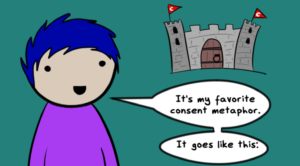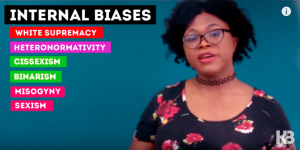Teachers are some of my favorite people in the world. I mean I really love teachers! They tend to be enthusiastic about changing society, and more often than not, they care so deeply about their work and their students. What’s not to like?
As a former teacher myself, I feel so very fortunate to meet teachers from all over the United States in my work. Despite all of the BS that teachers have to deal with in our political climate, they remain optimistic about the state of education, which honestly blows my mind.
It is from this place of love that I work with teachers to help them improve their practice. And with the realities of the “education debt” and considering that 80% of our teachers are White while nearly half (and growing) of our students are youth of Color, part of improving teaching practice means paying more critical attention to race in our schools.
Though I know there are actively racist teachers out there, most White teachers mean well and have no intention of being racist. Yet as people who are inscribed with Whiteness, it is possible for us to act in racist ways no matter our intentions. Uprooting racism from our daily actions takes a lifetime of work.
Thus, as we head into the first weeks of school all over the US, here are 10 ways that White teachers introduce racism into our schools paired with things we can do instead.
1. Lowering or Raising Achievement Expectations Based on Race/Ethnicity
It’s probably best to start with one of the more common and obvious ways that racism can enter teaching practice: our expectations of student ability and achievement.
Whether we acknowledge it or not, we are constantly inundated with racist messaging about what students can and can’t achieve.
Whether we see media narratives about the math prodigy Asian students or the “ghetto” Black students who are reading 5 grade levels behind, we end up getting pretty clear messages long before we start teaching about what our student can handle.
In my own teaching, I know that I had a hard time actually teaching my students within their ZPDs because I was told from before I even started teaching that they simply weren’t capable of writing complex papers about world events. But they could! All it took was coordinated effort from multiple teachers pushing them as hard as we could!
We know that the expectations students are held to often correlate less to their ability than their race and class, so what should we do about it?
What to Do Instead
First, we need to spend some serious time reflecting about our own internalized biases. We all have them (not sure about yours? Consider taking this test!). And if we are working to understand our biases, then we can begin to mitigate their effects.
Second, we need to be sure that we are using effective, non-culturally-biased measures to determine student ability and to push them to their zones of proximal development. By making sure we are basing the ways we push our students in data drawn from legitimate (if limiting) measures, we can hopefully use that data to check some of our own biases.
2. Being ‘Race Neutral’ Rather than Culturally Responsive
In my work with teachers, I sometimes meet teachers who claim that they “don’t see Color,” both in naïve attempts to be “progressive” but also in an ill-advised attempt to avoid tracking students based on race/ethnicity.
But our students don’t need a “race neutral” approach to their education.
There is endless research about how students of all races need a culturally responsive education; it’s just that White students who have White teachers are far more likely to receive one.
Culturally responsive teaching is not just a box that we can check with simple changes to curriculum. Instead, it is a pedagogical shift that all teachers must work to cultivate over the course of a career, one that works its way into every aspect of how we teach.
Part of culturally responsive teaching also demands that we not simply focus on the races of our students but, instead, turn the lens on our own racial identity.
Race neutrality lends itself to defensiveness to the ways Whiteness and racism are problematic in our teaching.
Cultural responsiveness demands that we do the difficult work of exploring a different way of being White, one where we see our liberation as bound up with that of our students and their families.
What to Do Instead
Start by reading the amazing literature on culturally responsive teaching, looking to Geneva Gay, Beverly Daniel Tatum, and Gary Howard for starters.
And get creative! One of the most amazing things I see in teachers is the wonderful imagination that so many use to reach students.
Apply that creativity to a race-conscious classroom, and we could see some powerful (and innovative) results.
Then share! Blog about them or publish them in educational publications (while being open to critical feedback) so that we can all learn together.
3. Using Racially Coded Language
With how common racially coded language in the US, there are surely words that enter our common vocab that can do damage to our efforts to build racially just schools.
Whether we’re referring to our students as “ghetto” or to their parents as “tiger moms” or saying “if only the parents cared about their kids education,” there are many overt ways that we can introduce racially coded language that devalues and/or otherizes our students and their families.
Perhaps even more common (particularly for White teachers in poorer, often urban areas) is treating our students as inspiration or poverty porn when talking to other White people.
This is one I know I have done many times. There is no need for me to include details about the harrowing life experiences of my students when talking to friends, yet I do so anyway to express just how “tough” things are for “those kids.”
While we may be able to argue that this is to help our White peers empathize, rarely is this done in any sort of humanizing way.
Rather, we are usually just trying to prove our credentials as a teacher who taught in the “inner city” or “the barrio.”
What to Do Instead
We as educators know the power of language, so we must be extra careful and precise with ours. We need to be hyper vigilant about how we talk about our students and their families/communities.
When we do the work to build relationships and to partner in the areas where we teach, then we see our students and their families as fully-realized human beings, and as a result, we can talk about our students in more humanizing ways.
Thus, we have a responsibility to do more than to just connect with our students. We have a responsibility to act in solidarity toward collective liberation!
4. Intentionally or Unintentionally Mispronouncing Names
One of the more subtle but powerful ways that White teachers inject racism into our schools is in how we engage with names that are different than those we grew up knowing.
Sometimes it shows up in simply not taking the time to learn how to properly pronounce a student’s name – but other times, it’s active resistance.
I can’t tell you how many times I have heard of teachers saying, “Their names are just too hard for me to pronounce,” so they settle for assigning nicknames.
What we communicate with this microaggression is that the student’s identity ought to conform to the world we know, not that we ought to be responsive to the student.
What to Do Instead
Take the time to learn names. Apologize when you get names wrong, and work really hard to learn names the right way.
Sometimes students who are used to White teachers mispronouncing their name will settle for you doing it “good enough.”
Stress that you don’t want “good enough.” You want to call them by the name they want to be called!
5. Enforcing Harsh Discipline Practices That Disproportionately Impact Students of Color
In virtually every school in the country, from the most mono-racial to the most diverse, discipline practices are set up to fail students of Color, both in design and implementation, and there are dire consequences for students who “struggle with discipline problems” in our world of hyper-criminalization.
Ta-Nehisi Coates demonstrated well in a recent interview how a lack of cultural awareness on the part of White teachers can lead to serious consequences for Black students who grow up in violent neighborhoods.
Describing an incident where he was suspended for threatening a teacher who yelled at him in class, he noted how when “you don’t have anything else to lean on” except the basic respect of others, it means something wholly different than for students from a wholly different cultural context to have a teacher scream in their face.
What to Do Instead
In our own classrooms, we have to be willing to carefully investigate how we dole out discipline and work to change our practices.
Do our management procedures reward students whose cultural backgrounds and expressions of, say, showing excitement reflect our own while punishing those who express these things differently?
Perhaps more importantly, though, this is a problem that must be addressed in community.
If you are great about mitigating racial bias in your management but your school has a zero-tolerance discipline system that sees kids leaving in handcuffs for acting out in school, then we must organize together as educators.
It’s time to get cops out of our schools and to demand discipline policies that are based on principles of nonviolence and restorative justice.
6. (Inadvertently) Valuing Whiteness
One of the more insidious ways that White teachers bring racism into schools is in how we (often inadvertently) value Whiteness and European ways of being above all others.
Whether we are strictly teaching the “canon” that is almost exclusively White or using examples in math or science problems that are more accessible to White and/or wealthy students than others, White teachers inject Whiteness into our classrooms all the time.
In my own teaching, I found that I was calling my lightest-skinned students (in an almost all-Black classroom) by name when I couldn’t remember the names as readily of darker-skinned students.
That’s valuing Whiteness.
What to Do Instead
We need to do obvious things like diversifying our curriculum and our materials, but beyond that, we must look inside for the more insidious ways that we value Whiteness.
By questioning all aspects of how we teach to consider whether we are devaluing some people and valuing others, we are taking important steps toward racially just pedagogy.
7. Tokenizing Students’ Cultures to Connect with Them
The other side of the coin that comes with diversifying our curriculum and materials is that it can be done in a tremendously tokenizing way.
If we don’t get to know our students first, then we might assume that our Dominican students and our students from northeastern Mexico all are the same and that they all could relate to a book about the migrant farm struggle in the southwestern US.
Thus, we have to be careful not to tokenize students’ identities in our efforts to connect with them.
What to Do Instead
It’s a lot more work, but we ought to consider waiting to decide on the books we teach or the curricular examples until we’ve had some time to listen to our students and their families.
Ask questions about what they want to learn about, and listen and respond accordingly!
Unfortunately that means that we can’t just teach the same exact ways every year, but there are all sorts of resources to help!
8. Culturally Appropriate in an Effort to Connect with Students
For many of us White teachers who grew up with little-to-know exposure to people and cultures of Color and who don’t have a connection to our own ethnic cultural identities outside of Whiteness (notably, a lack of cultural identity), it can be hard to know how to connect with students.
Unfortunately, this often means appropriating other cultures, particularly those of our students, to try to connect with them.
A friend, mentor, and my co-author in an upcoming piece about White teachers who wish to develop anti-racist ways of being, Shelly Tochluk, cites a time when she wore a lappa (African skirt), an ankh around her neck, and carried a djembe to class in a misguided effort to connect.
Reflecting on the experience, Shelly notes that it would have been far better to “include more African American voices into the curriculum.”
If you’re not sure exactly why this is a problem, perhaps look here and here.
Otherwise…
What to Do Instead
Invest in understanding your own ethnic, religious, and cultural heritage (particularly that from before your people became White) through an anti-racist lens.
Then work hard to create space for authentic and accountable cultural exchange in your classroom!
9. Devaluing What Non-Teachers Contribute to the School Community
Everyone is trying to tell teachers how to do their job, and teachers are sick of hearing it from non-teachers.
But from some White teachers, I hear the “if you haven’t taught, don’t tell me how to do my job” mantra used as a blanket for everyone from Bill Gates to the parents and community advocates where they teach.
When we decide that teachers are the gatekeepers to what works in education and when the vast majority of teachers are White, we end up devaluing the insights and knowledge that many people of Color offer.
What to Do Instead
From parents to community leaders to other non-White staff in your building, there’s a lot we can learn if we are willing to humbly listen to people of Color and implement what we learn about race in education.
Actively seek to build relationships across difference and seek input in your classroom.
Hell, invite folks into your classroom to observe and share and teach!
10. Doing Little or Nothing to Advocate for More Teachers and Staff of Color
Finally, and probably most importantly, there’s simply no substitute to teachers of Color teaching students who share their race (see here, here, here, and here).
Unfortunately, many progressive White teachers note that it would be great to have more teachers of Color, but at the end of the day, what are we doing about it?
What to Do Instead
Organize! It’s what teachers do so well! Pressure our unions to make hiring teachers of Color the top priority.
Advocate for alternative licensing options for paraprofessionals and teaching aides (who are disproportionately people of Color, especially in cities). Get on hiring committees at your school and ask hard questions about what we consider “qualified candidates.”
This is somewhere that well-meaning White teachers can have a profound impact if we’re willing to invest our energy.
***
Regardless of what it looks like, we need more White teachers who are willing to do the hard work of combatting the subtle racism we bring into our schools while working vociferously to change our own pedagogies and make our schools more racially just places!
If not now, when? If not us, who?
[do_widget id=’text-101′]
Jamie Utt is a Contributing Writer for Everyday Feminism. He is the Founder and Director of Education at CivilSchools, a comprehensive bullying prevention program, a diversity and inclusion consultant, and sexual violence prevention educator based in Tucson, AZ. He is currently working toward his PhD in Teaching, Learning, and Sociocultural Studies at the University of Arizona with research interests in the role that White teacher’s racial identity plays in their teaching practice. Learn more about his work at his website here and follow him on Twitter @utt_jamie. Read his articles here and book him for speaking engagements.
Search our 3000+ articles!
Read our articles about:
Our online racial justice training
Used by hundreds of universities, non-profits, and businesses.
Click to learn more





















